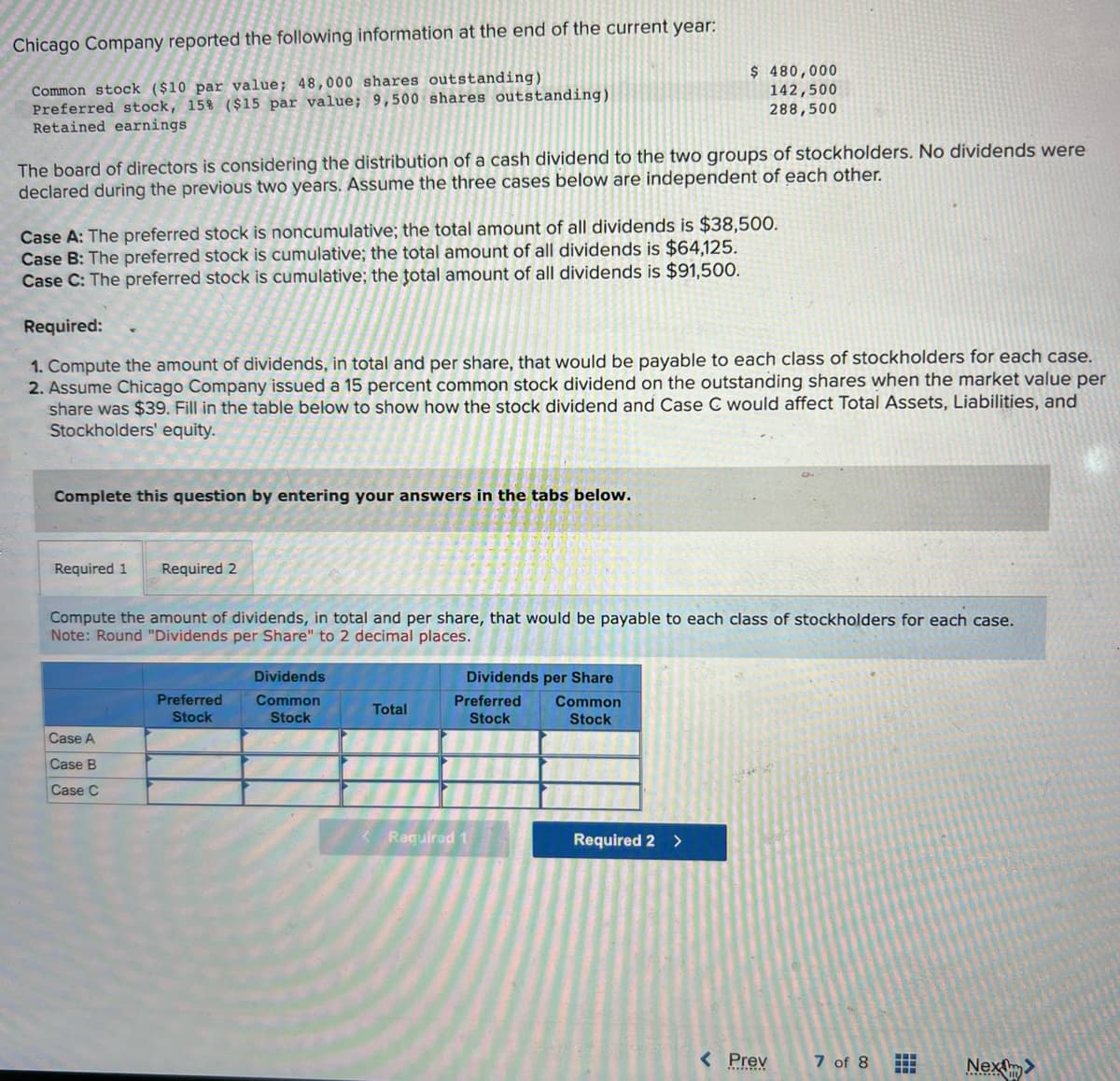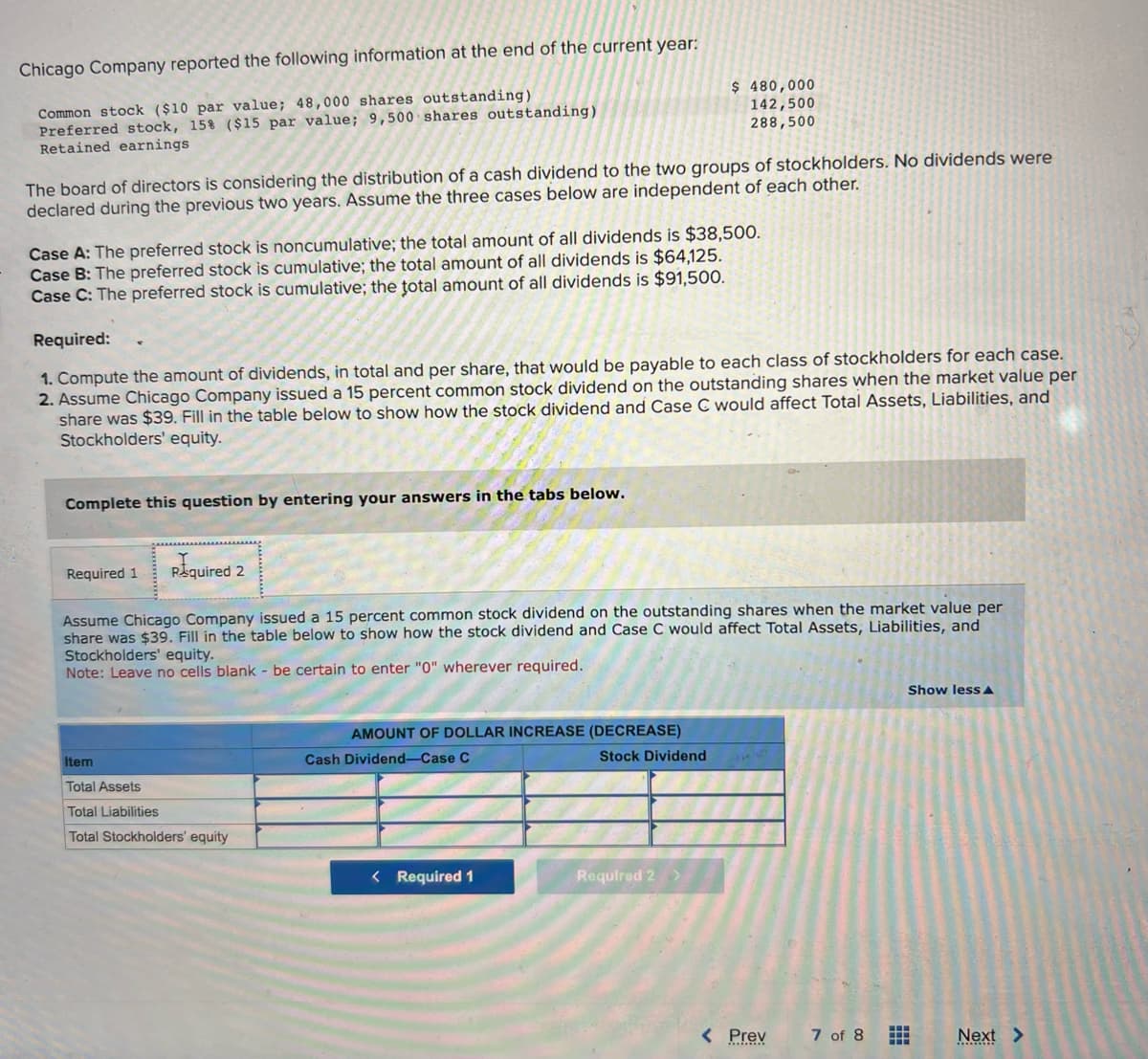Common stock ($10 par value; 48,000 shares outstanding) Preferred stock, 15% ($15 par value; 9,500 shares outstanding) Retained earnings The board of directors is considering the distribution of a cash dividend to the two groups of stockholders. No dividends were declared during the previous two years. Assume the three cases below are independent of each other. Case A: The preferred stock is noncumulative; the total amount of all dividends is $38,500. Case B: The preferred stock is cumulative; the total amount of all dividends is $64,125. Case C: The preferred stock is cumulative; the total amount of all dividends is $91,500. Required: 1. Compute the amount of dividends, in total and per share, that would be payable to each class of stockholders for each case. 2. Assume Chicago Company issued a 15 percent common stock dividend on the outstanding shares when the market value per share was $39. Fill in the table below to show how the stock dividend and Case C would affect Total Assets, Liabilities, and Stockholders' equity. Complete this question by entering your answers in the tabs below. Required 1 Required 2 Compute the amount of dividends, in total and per share, that would be payable to each class of stockholders for each case. Note: Round "Dividends per Share" to 2 decimal places. Case A Case B Case C Preferred Stock Dividends Common Stock Total $ 480,000 142,500 288,500 Dividends per Share Common Stock Preferred Stock Required 1 Required 2 > < Prev 7 of 8 www E Nex>
Common stock ($10 par value; 48,000 shares outstanding) Preferred stock, 15% ($15 par value; 9,500 shares outstanding) Retained earnings The board of directors is considering the distribution of a cash dividend to the two groups of stockholders. No dividends were declared during the previous two years. Assume the three cases below are independent of each other. Case A: The preferred stock is noncumulative; the total amount of all dividends is $38,500. Case B: The preferred stock is cumulative; the total amount of all dividends is $64,125. Case C: The preferred stock is cumulative; the total amount of all dividends is $91,500. Required: 1. Compute the amount of dividends, in total and per share, that would be payable to each class of stockholders for each case. 2. Assume Chicago Company issued a 15 percent common stock dividend on the outstanding shares when the market value per share was $39. Fill in the table below to show how the stock dividend and Case C would affect Total Assets, Liabilities, and Stockholders' equity. Complete this question by entering your answers in the tabs below. Required 1 Required 2 Compute the amount of dividends, in total and per share, that would be payable to each class of stockholders for each case. Note: Round "Dividends per Share" to 2 decimal places. Case A Case B Case C Preferred Stock Dividends Common Stock Total $ 480,000 142,500 288,500 Dividends per Share Common Stock Preferred Stock Required 1 Required 2 > < Prev 7 of 8 www E Nex>
Chapter14: Corporation Accounting
Section: Chapter Questions
Problem 9PA: Aggregate Mining Corporation was incorporated five years ago. It is authorized to issue 500,000...
Related questions
Question

Transcribed Image Text:Chicago Company reported the following information at the end of the current year:
Common stock ($10 par value; 48,000 shares outstanding)
Preferred stock, 15% ($15 par value; 9,500 shares outstanding)
Retained earnings
The board of directors is considering the distribution of a cash dividend to the two groups of stockholders. No dividends were
declared during the previous two years. Assume the three cases below are independent of each other.
Case A: The preferred stock is noncumulative; the total amount of all dividends is $38,500.
Case B: The preferred stock is cumulative; the total amount of all dividends is $64,125.
Case C: The preferred stock is cumulative; the total amount of all dividends is $91,500.
Required:
1. Compute the amount of dividends, in total and per share, that would be payable to each class of stockholders for each case.
2. Assume Chicago Company issued a 15 percent common stock dividend on the outstanding shares when the market value per
share was $39. Fill in the table below to show how the stock dividend and Case C would affect Total Assets, Liabilities, and
Stockholders' equity
Complete this question by entering your answers in the tabs below.
Required 1 Required 2
Compute the amount of dividends, in total and per share, that would be payable to each class of stockholders for each case.
Note: Round "Dividends per Share" to 2 decimal places.
Case A
Case B
Case C
Preferred
Stock
Dividends
Common
Stock
$ 480,000
142,500
288,500
Total
Dividends per Share
Preferred Common
Stock
Stock
Required 1
Required 2 >
< Prev
7 of 8
www
--
Nex>

Transcribed Image Text:Chicago Company reported the following information at the end of the current year:
Common stock ($10 par value; 48,000 shares outstanding)
Preferred stock, 15% ($15 par value; 9,500 shares outstanding)
Retained earnings
The board of directors is considering the distribution of a cash dividend to the two groups of stockholders. No dividends were
declared during the previous two years. Assume the three cases below are independent of each other.
Case A: The preferred stock is noncumulative; the total amount of all dividends is $38,500.
Case B: The preferred stock is cumulative; the total amount of all dividends is $64,125.
Case C: The preferred stock is cumulative; the total amount of all dividends is $91,500.
Required:
1. Compute the amount of dividends, in total and per share, that would be payable to each class of stockholders for each case.
2. Assume Chicago Company issued a 15 percent common stock dividend on the outstanding shares when the market value per
share was $39. Fill in the table below to show how the stock dividend and Case C would affect Total Assets, Liabilities, and
Stockholders' equity.
Complete this question by entering your answers in the tabs below.
Required 2
Assume Chicago Company issued a 15 percent common stock dividend on the outstanding shares when the market value per
share was $39. Fill in the table below to show how the stock dividend and Case C would affect Total Assets, Liabilities, and
Stockholders' equity.
Note: Leave no cells blank - be certain to enter "0" wherever required.
Required 1
Item
Total Assets
Total Liabilities
Total Stockholders' equity
$ 480,000
142,500
288,500
AMOUNT OF DOLLAR INCREASE (DECREASE)
Stock Dividend
Cash Dividend-Case C
< Required 1
Required 2 >
< Prev
7 of 8
Show less A
Next >
Expert Solution
This question has been solved!
Explore an expertly crafted, step-by-step solution for a thorough understanding of key concepts.
This is a popular solution!
Trending now
This is a popular solution!
Step by step
Solved in 4 steps

Recommended textbooks for you

Principles of Accounting Volume 1
Accounting
ISBN:
9781947172685
Author:
OpenStax
Publisher:
OpenStax College

Excel Applications for Accounting Principles
Accounting
ISBN:
9781111581565
Author:
Gaylord N. Smith
Publisher:
Cengage Learning

Intermediate Accounting: Reporting And Analysis
Accounting
ISBN:
9781337788281
Author:
James M. Wahlen, Jefferson P. Jones, Donald Pagach
Publisher:
Cengage Learning

Principles of Accounting Volume 1
Accounting
ISBN:
9781947172685
Author:
OpenStax
Publisher:
OpenStax College

Excel Applications for Accounting Principles
Accounting
ISBN:
9781111581565
Author:
Gaylord N. Smith
Publisher:
Cengage Learning

Intermediate Accounting: Reporting And Analysis
Accounting
ISBN:
9781337788281
Author:
James M. Wahlen, Jefferson P. Jones, Donald Pagach
Publisher:
Cengage Learning

Financial Accounting
Accounting
ISBN:
9781305088436
Author:
Carl Warren, Jim Reeve, Jonathan Duchac
Publisher:
Cengage Learning

Financial And Managerial Accounting
Accounting
ISBN:
9781337902663
Author:
WARREN, Carl S.
Publisher:
Cengage Learning,

Cornerstones of Financial Accounting
Accounting
ISBN:
9781337690881
Author:
Jay Rich, Jeff Jones
Publisher:
Cengage Learning